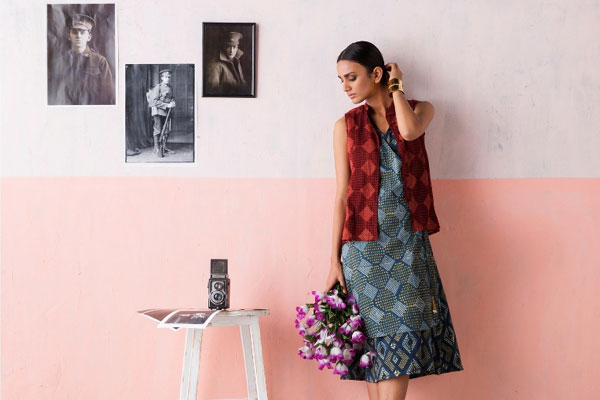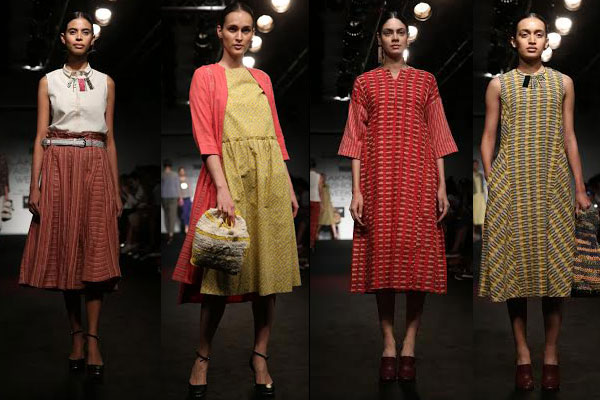
Green activists worldwide have been campaigning for long to bring the world to adopt an eco-friendly approach before the impact of pollution, deforestation and soil erosion wreck havoc on the planet immeasurably. At last, it is having some impact among responsible citizens and countries committing to the limit pollution.
The new breed of fashion designers in the country are also putting their weight behind the cause of sustainability. They encourage fashion with a conscience using home-grown products and designing wardrobes with desiethnicity. Garments are getting manufactured from organic fabrics and materials. It also means giving support to the local cottage industry by facilitating job opportunities for indigenous artisans, craftsmen, weavers and labourers. Additionally, the products come at a reasonable price-range, but keeping intact the aesthetic values and quality.
Agrees designer Nidhi Munim, “Sustainable fashion is all about being environ-friendly with affordability. It’s definitely not a short-term trend but a design philosophy that we as socially responsible couturiers must adhere to.” It involves using natural dyes, zero waste production and up-cycling. “It’s about using hundred per cent organic cotton clothing which in turn increases comfort and makes for practical sense in our hot country,” she says.
Designer-duo Jaya Bhatt and Ruchi Tripathi of Indigene brand often caters to sustainable sartorial lines. They feel, “Slowly but steadily, people are becoming aware of better options and this is greatly motivating us to turn out items that are eco-friendly. This also explains why a lot of designers today are sourcing handmade commodities, involving cheaper manual labour and low-cost natural stuff.”
They point out that “The growing consciousness amongst the general public about our depleting resources and the fast languishing crafts and skills of our age-old cultural heritage has propelled the fashion industry to stop and think about the necessary changes to be brought in”.
 Dresses, fashionable trousers, pants, tops, maxis and shirts are commonly seen using sustainable fabrics. They come in as single piece outfits or separates for both women and menswear. All sorts of garments from traditional wear to modern interpretations of jackets and overlays can be created in handmade fabrics, applying fair methods.
Dresses, fashionable trousers, pants, tops, maxis and shirts are commonly seen using sustainable fabrics. They come in as single piece outfits or separates for both women and menswear. All sorts of garments from traditional wear to modern interpretations of jackets and overlays can be created in handmade fabrics, applying fair methods.
Many new and established designers are consciously moving towards using recyclable raw material and ethical work spaces to produce and create wares that do not compromise on quality and sustainability.
Designer Ritika Arya Jain emphasises that “Both designers as well as consumers have understood the importance of using organic fabrics that do not harm the environ and are taking a paradigm shift. They are resorting to more biodegradable items now and are also finding alternative means to adopt in the wake of ban on plastic bags”.
Considering India’s wealth of natural fibre and native crops it can be the country’s USP to the growing demand for sustainable fashion industy worldwide. Outfits made from cotton, jute, bamboo (used for viscose) and beech wood (used for rayon) are some, to name a few.
“India has always been known as a land of cotton growers, though the current water crisis across the country is dangerous for this fibre, but the non-hybrid variety of local Indian cotton is adaptable to the climate, can withstand diseases, water scarcity and also adverse climatic conditions. Silk rearing is also done in large parts of the country and recently, linen yarn is also being produced in India,” inform Jaya and Ruchi. Soy, hemp, banana, lotus, pineapple, ahimsa silk and bamboo are some more examples to add to this list.
Incidentally, domestic designers are also selling their skills and brands to promote on a global scale. This would not only boost the ongoing ‘make in India’ initiative but also lure in clients and investments from abroad. Of late, reputed designer Anita Dongre’s ‘Gulrukh’ dress received an unusual taker of a royal kind. The high-profile guest to India, the Duchess of Cambridge, Kate Middleton, donned Dongre’s designs on her recent visit to India. The princess flaunted a delicately printed georgette dress by the Mumbai-based designer during aSunday cricket match and the ensuing tour of the Maximun City’s neglected pockets. The line was originally launched at Lakme Fashion Week earlier this year in its full-length size, including a conventional stole in matching fabric. The duchess and her stylist Natasha Archer further customised the apparel cleverly by shearing it off to look like a dress and transformed a part of the stole into a belt. This do-it-yourself move drew praises from fashion circles all over, including the creator.
The palette suggested by the dressmakers is mainly earthy and eye-soothing. “Colours like earthy tones, indigos, clay dyes and other natural tints are apt for sustainable creations,” recommends Munim. She reveals that a lot of textile exponents like to work with kora or off-loom natural fabrics in off-white shades without dyes, while others prefer to go for natural hues. “The palette is muted and subtle ranging between calming indigos to rich pigments and plain grays. These are no less intense shades, yet they leave a soothing effect unlike chemical dyes and processed fabrics,” she says.
For Jain, cement gray, white, ivory, black, earthy browns, denim blue, pastel blues, khaki and light pinks form the perfect shade-card for sustainable style of clothing.
Apart from caring for the environ, the designers also have to be concerned about the working conditions and wages of their battery of staff. When asked how fashion designers can ensure that, Munim replies “By paying adequate wages to artisans and tailors, having a work-compatible environment and space enough to ideate, express and create, things can hopefully be upgraded. Add to this, provision of basic amenities like health-care service, insurance and loan benefits to the employees”.
Support Our Journalism
We cannot do without you.. your contribution supports unbiased journalism
IBNS is not driven by any ism- not wokeism, not racism, not skewed secularism, not hyper right-wing or left liberal ideals, nor by any hardline religious beliefs or hyper nationalism. We want to serve you good old objective news, as they are. We do not judge or preach. We let people decide for themselves. We only try to present factual and well-sourced news.







